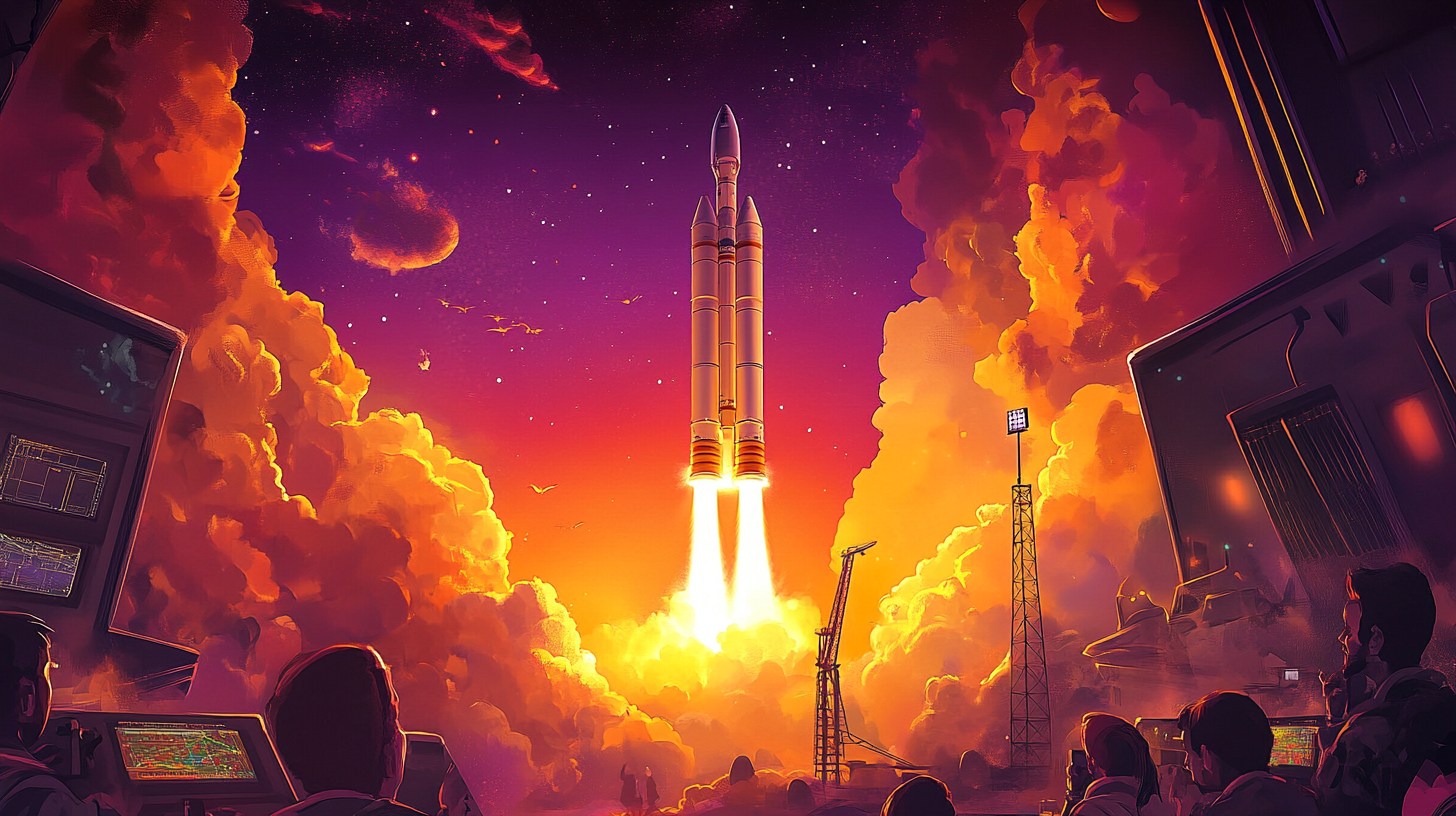India conquers space: ISRO's ambitious plans - Where does India stand internationally compared to SpaceX, China and Russia?
Xpert pre-release
Language selection 📢
Published on: January 1, 2025 / update from: January 1, 2025 - Author: Konrad Wolfenstein

India conquers space: ISRO's ambitious plans - Where does India stand in international comparison to SpaceX, China and Russia - Image: Xpert.Digital
India's Space: An Emerging Power in Space
India has established itself as a major force in space exploration in recent years. With a series of successful missions and ambitious plans for the future, the country is consolidating its position in the global space community. Join us on a journey through the fascinating world of Indian space travel and discover the latest achievements, the ambitious future plans and the challenges that India must overcome on its way to becoming a leading space nation.
The Indian Space Agency (ISRO).
The Indian Space Research Organization (ISRO) is India's national space agency. Their headquarters are in Bengaluru. ISRO is responsible for planning, executing and monitoring space missions as well as developing space technologies. It reports to the Department of Space (DoS), which reports directly to the Prime Minister of India. The chairman of ISRO is also the head of the DoS.
The history of ISRO dates back to 1962 when the Indian National Committee for Space Research (INCOSPAR) was founded. On August 15, 1969, INCOSPAR was replaced by ISRO, which was entrusted with an expanded area of responsibility. In 1972, the Department of Space (DoS) was established and ISRO was placed under it. This move institutionalized space exploration in India and laid the foundation for today's Indian space program.
Latest Indian Space News
India has closed 2024 with a number of notable achievements in space. A highlight was the launch of the SpaDeX mission (Space Docking Experiment) on December 30th. With this mission, India has taken an important step towards building its own space station and conducting more complex space missions. The SpaDeX satellites are the first to be built entirely by Indian industry under the leadership of ISRO. This highlights the growing contribution of the private sector to Indian space travel.
Another milestone is the upcoming launch of ISRO's 100th rocket from the Satish Dhawan Space Center in January 2025. This launch will be carried out using the Geosynchronous Satellite Launch Vehicle (GSLV) and marks a significant achievement for the Indian space agency. Additionally, ISRO has conducted a total of 15 missions in 2024, strengthening private sector participation.
Recent space missions and achievements
India has carried out an impressive series of successful space missions in recent years. The most important include:
XPoSat
On January 1, 2024, ISRO launched the X-ray Polarimeter Satellite (XPoSat). This is India's first dedicated mission to study the X-ray polarization of celestial sources. With XPoSat, India is positioning itself as one of the few nations capable of conducting such advanced astronomical studies.
INSAT-3DS
In February 2024, the INSAT-3DS weather satellite was successfully launched with a GSLV-F14 rocket. INSAT-3DS enhances India's capabilities in environmental monitoring, ocean observation and disaster response. The satellite provides important data for weather forecasts, climate research and disaster management.
Chandrayaan-3
On August 23, 2023, India successfully landed Chandrayaan-3 on the moon. This mission was a historic moment for India and cemented its position as a leading spacefaring nation. Chandrayaan-3 provided valuable data on the composition of the lunar soil and the availability of water resources.
Aditya-L1
In September 2023, India launched its first solar mission, Aditya-L1. The probe reached the Lagrange point L1 on January 6, 2024 and has begun studying the solar atmosphere. Aditya-L1 will provide data on solar activity, the solar corona and the solar wind, which are critical to understanding space weather and its impact on Earth.
SpaDeX
The SpaDeX (Space Docking Experiment) mission, launched on December 30, 2024, is another important milestone for Indian space travel. This mission placed two small satellites into a circular orbit at an altitude of 475 km using a PSLV-C60 rocket. The mission's goal is to test autonomous docking technology in orbit. This technology is crucial for building your own space station and carrying out more complex space missions, such as: B. returning lunar samples to Earth. The first docking attempt could take place as early as January 7, 2025.
Plans for future space missions
India has ambitious plans for future space missions. Key objectives include:
Gaganyaan
India's first manned space mission, Gaganyaan, is scheduled to launch in 2025. The goal is to send a crew of three into a 400 km high orbit for three days. With Gaganyaan, India will enter the exclusive circle of nations capable of launching humans into space.
Chandrayaan-4
Another lunar mission, Chandrayaan-4, is planned for 2027-28. This mission is intended to collect lunar samples and return them to Earth. Chandrayaan-4 will expand knowledge about the moon and its formation.
Venus Orbiter Mission
A mission to Venus is planned for March 2028. The probe is intended to examine the atmosphere of Venus and provide new insights into this fascinating planet.
Lunar Polar Exploration Mission
In collaboration with the Japanese space agency JAXA, India is planning a mission to explore the south pole of the moon. This mission will advance the search for water ice and other resources in this region of the Moon.
Bharatiya Antariksha Station
India plans to build its own space station, which is scheduled to be completed between 2028 and 2035. The space station will serve as a platform for scientific experiments and technological developments.
Roadmap for the future
Prime Minister Modi has directed ISRO to prepare a roadmap for building an Indian space station by 2035 and sending an Indian to the moon by 2040. These ambitious goals underscore India's long-term vision for space exploration.
Reusable launch vehicle technology
India is working on developing reusable spacecraft. In April 2023, ISRO successfully tested a Reusable Launch Vehicle Autonomous Landing Mission (RLV LEX). This technology has the potential to reduce the cost of space launches and increase the frequency of missions.
Military Applications of Space Technology
India's Defense Space Agency (DSA) has submitted a request for a mobile launch system. This system is said to be capable of placing payloads of approximately 0.71 tons into orbit. Mobile launch systems offer greater flexibility and resilience compared to stationary launch sites.
Space Biology Research
ISRO is collaborating with the Department of Biotechnology to explore biological applications in space. This collaboration aims to study the effects of the space environment on living organisms and provide new insights for medicine and biotechnology.
Comparison with other spacefaring nations
Although India has made great strides in space travel in recent years, there are still differences in budget and experience compared to the US and China. The US has a significantly larger budget and a longer history of space exploration. NASA has extensive experience in human spaceflight missions and solar system exploration. India and the US cooperate in various areas, including planetary defense to protect the Earth from asteroid impacts.
China has invested heavily in its space program in recent years and plans to expand and commercialize its space systems beyond its borders. India, on the other hand, focuses on traditional space goals such as satellite launches and interplanetary missions. China plans to conduct about 100 space launches in 2025, while India plans 30 launches by March 2025. India is working on developing satellite internet, but there is still no clear government plan to make this a critical infrastructure.
Russia has a long tradition in space travel and was the first country to send a human into space. However, after the collapse of the Soviet Union, the Russian space program faced financial and technical challenges.
India takes a cost-effective approach to space and focuses on developing technologies relevant to national development. The country has proven to be a reliable partner for international cooperation.
Economic and technological impacts
India's space program has significant economic and technological implications. Investments in space have led to innovations in various areas, including telecommunications, weather forecasting, disaster management and agriculture.
India's space sector has contributed $60 billion to GDP and created 4.7 million jobs in the last decade. For every dollar invested in the space sector, there is a multiplier effect of US$2.54 on the Indian economy. The space sector has contributed Rs 20,000 crore to India's GDP in the last decade and created 96,000 jobs in the public and private sectors. India is the eighth largest space nation in the world in terms of funding and is witnessing rapid growth of startups in this sector.
ISRO has also contributed to the development of indigenous technologies such as the Indian Regional Navigation Satellite System (IRNSS) and the Polar Satellite Launch Vehicle (PSLV). These technologies strengthen India's independence and its position in international competition.
India's space program is in a dynamic phase of development
With a series of successful missions, ambitious plans for the future and a focus on cost-effective solutions, India has established itself as a major force in space exploration. ISRO plays an important role in national development and contributes to technological advancements in various fields.
However, India also faces challenges. ISRO's budget is limited compared to the US and China. Collaboration with international partners and the private sector will be crucial to achieving India's ambitious goals. India needs to further expand its technological capabilities to compete internationally.
Despite these challenges, the future prospects for India's space program are promising. The growing economy and increasing importance of technology in India create a favorable environment for the further development of space travel. India has the potential to play a leading role in the global space community and make a significant contribution to space exploration.
Our recommendation: 🌍 Limitless reach 🔗 Networked 🌐 Multilingual 💪 Strong sales: 💡 Authentic with strategy 🚀 Innovation meets 🧠 Intuition
At a time when a company's digital presence determines its success, the challenge is how to make this presence authentic, individual and far-reaching. Xpert.Digital offers an innovative solution that positions itself as an intersection between an industry hub, a blog and a brand ambassador. It combines the advantages of communication and sales channels in a single platform and enables publication in 18 different languages. The cooperation with partner portals and the possibility of publishing articles on Google News and a press distribution list with around 8,000 journalists and readers maximize the reach and visibility of the content. This represents an essential factor in external sales & marketing (SMarketing).
More about it here:
We are there for you - advice - planning - implementation - project management
☑️ SME support in strategy, consulting, planning and implementation
☑️ Creation or realignment of the digital strategy and digitalization
☑️ Expansion and optimization of international sales processes
☑️ Global & Digital B2B trading platforms
☑️ Pioneer Business Development
I would be happy to serve as your personal advisor.
You can contact me by filling out the contact form below or simply call me on +49 89 89 674 804 (Munich) .
I'm looking forward to our joint project.
Xpert.Digital - Konrad Wolfenstein
Xpert.Digital is a hub for industry with a focus on digitalization, mechanical engineering, logistics/intralogistics and photovoltaics.
With our 360° business development solution, we support well-known companies from new business to after sales.
Market intelligence, smarketing, marketing automation, content development, PR, mail campaigns, personalized social media and lead nurturing are part of our digital tools.
You can find out more at: www.xpert.digital - www.xpert.solar - www.xpert.plus


























